Nanofiber NiMoO4/g-C3N4 Composite Electrode Materials for Redox Supercapacitor Applications
Abstract
:1. Introduction
2. Experimental Section
2.1. Preparation of g-C3N4
2.2. Preparation of NiMoO4/g-C3N4 by Hydrothermal Method
2.3. Preparation of Electrode Material
2.4. Electrochemical Measurements
3. Results and Discussion
3.1. XRD Analysis
3.2. Fourier Transform Infrared (FTIR) Spectroscopy
3.3. Surface Morphology and Elemental Studies
3.4. CV Studies
3.5. GCD Studies
3.6. EIS Studies
4. Conclusions
Author Contributions
Funding
Conflicts of Interest
References
- Zhai, S.; Karahan, H.E.; Wei, L.; Qian, Q.; Harris, A.T.; Minett, A.I.; Ramakrishna, S.; Ng, Y.A.K.; Chen, Y. Textile Energy Storage: Structural Design Concepts, Material Selection and Future Perspectives. Energy Storage Mater. 2016, 3, 123–139. [Google Scholar] [CrossRef]
- Miller, J.R.; Simon, P. Electrochemical Capacitors for Energy Management. Science 2008, 321, 651–652. [Google Scholar] [CrossRef] [PubMed] [Green Version]
- Simon, P.; Gogotsi, Y. Materials for Electrochemical Capacitors. Nat. Mater. 2008, 7, 845–848. [Google Scholar] [CrossRef] [PubMed] [Green Version]
- Lu, X.; Yu, M.; Wang, G.; Tong, Y.; Li, Y. Flexible Solid-State Supercapacitors: Design, Fabrication and Applications. Energy Environ. Sci. 2014, 7, 2160–2181. [Google Scholar] [CrossRef]
- Yoo, J.J.; Balakrishnan, K.; Huang, J.; Meunier, V.; Sumpter, B.G.; Srivastava, A.; Conway, M.; Reddy, A.L.M.; Yu, J.; Vajtai, R.; et al. Ultrathin Planar Graphene Supercapacitors. Nano Lett. 2011, 11, 1423–1427. [Google Scholar] [CrossRef] [PubMed]
- Huang, Y.; Liang, J.; Chen, Y. An Overview of the Applications of Graphene-Based Materials in Supercapacitors. Small 2012, 8, 1805. [Google Scholar] [CrossRef]
- Zhang, L.Y.; Tang, C.H.; Gong, H. Temperature Effect on the Binder-Free Nickel Copper Oxide Nanowires with Superior Supercapacitor Performance. Nanoscale 2014, 6, 12981–12989. [Google Scholar] [CrossRef]
- Arul, N.S.; Mangalaraj, D.; Ramachandran, R.; Grace, A.N.; Han, J.J.I. Fabrication of CeO2/Fe2O3 Composite Nanospindles for Enhanced Visible Light Driven Photocatalysts and Supercapacitor Electrodes. J. Mater. Chem. A 2015, 3, 15248–15258. [Google Scholar] [CrossRef]
- Subramanian, V.; Hall, S.C.; Smith, P.H.; Rambabu, B. Mesoporous Anhydrous RuO2 as a Supercapacitor Electrode Material. Solid State Ion. 2004, 175, 511–515. [Google Scholar] [CrossRef]
- Ming, B.; Li, J.; Kang, F.; Pang, G.; Zhang, Y.; Chen, L.; Xu, J.; Wang, X. Microwave–Hydrothermal Synthesis of Birnessite-Type MnO2 Nanospheres as Supercapacitor Electrode Materials. J. Power Sources 2012, 198, 428–431. [Google Scholar] [CrossRef]
- Ghosh, D.; Giri, S.; Das, C.K. Preparation of CTAB-Assisted Hexagonal Platelet Co(OH)2/Graphene Hybrid Composite as Efficient Supercapacitor Electrode Material. Acs Sustain. Chem. Eng. 2013, 1, 1135–1142. [Google Scholar] [CrossRef]
- Yuan, C.; Zhang, X.; Su, L.; Gao, B.; Shen, L. Facile Synthesis and Self-Assembly of Hierarchical Porous NiO Nano/Micro Spherical Superstructures for High Performance Supercapacitors. J. Mater. Chem. 2009, 19, 5772–5777. [Google Scholar] [CrossRef]
- Xu, J.; Ding, T.T.; Wang, J.; Zhang, J.; Wang, S.; Chen, C.Q.; Fang, Y.Y.; Wu, Z.B.; Huo, K.F.; Dai, J.N. Tungsten Oxide Nanofibers Self-Assembled Mesoscopic Microspheres as High-performance Electrodes for Supercapacitor. Electrochim. Acta 2015, 174, 728–734. [Google Scholar] [CrossRef]
- Chen, Y.; Meng, F.; Ma, C.; Yang, Z.; Zhu, C.; Ouyang, Q.; Gao, P.; Li, J.; Sun, C. In-situ diffusion Growth of Fe2(MoO4)3 Nanocrystals on the Surface of α-MoO3 Nanorods with Significantly Enhanced Ethanol Sensing Properties. J. Mater. Chem. 2012, 22, 12900–12906. [Google Scholar] [CrossRef]
- Xiao, W.; Chen, J.S.; Li, C.M.; Xu, R.; Lou, X.W. Synthesis, Characterization, and Lithium Storage Capability of AMoO4 (A = Ni, Co) Nanorods. Chem. Materials 2010, 22, 746. [Google Scholar]
- Guo, D.; Zhang, P.; Zhang, H.; Yu, X.; Zhu, J.; Li, Q.; Wang, T. NiMoO4 Nanowires Supported on Ni Foam as Novel Advanced Electrodes for Supercapacitors. J. Mater. Chem. A 2013, 1, 9024–9027. [Google Scholar] [CrossRef]
- Lin, L.; Liu, T.; Liu, J.; Sun, R.; Hao, J.; Ji, K.; Wang, Z. Growth-Controlled Nico2s4 Nanosheet Arrays with Self-Decorated Nanoneedles for High-Performance Pseudocapacitors. Appl. Surf. Sci. 2016, 360, 234–239. [Google Scholar] [CrossRef]
- Senthilkumar, B.; Sankar, K.V.; Kalaiselvan, R.; Danielle, M.; Manickam, M. Nano α-NiMoO4 as a New Electrode for Electrochemical Supercapacitors. RSC Adv. 2013, 3, 352–357. [Google Scholar] [CrossRef]
- Raja, P.; Kannan, J.; Rahul, S.; Salunkhe, R.; Pramanik, M.; Malgras, V.; Alshehri, S.M.; Yamauchi, Y. Synthesis and Characterization of α-NiMoO4 Nanorods for Supercapacitor Application. Eur. J. Inorg. Chem. 2015, 2015, 3694–3699. [Google Scholar]
- Wang, Z.; Wei, G.; Kun, D.; Zhao, X.; Liu, M.; Wang, S.; Zhou, Y.; An, C.; Zhang, J. Ni Foam-Supported Carbon-Sheathed NiMoO4 Nanowires as Integrated Electrode for High-Performance Hybrid Supercapacitors. ACS Sustain. Chem. Eng. 2017, 5, 5964–5971. [Google Scholar] [CrossRef]
- Liu, M.C.; Kong, L.B.; Lu, C.; Ma, X.J.; Li, X.M.; Luo, Y.C.; Kang, L. Design and synthesis of CoMoO4–NiMoO4·xH2O Bundles with Improved Electrochemical Properties for Supercapacitors. J. Mater. Chem. A 2013, 1, 1380–1387. [Google Scholar] [CrossRef]
- Senthilkumar, B.; Meyrick, D.; Leec, Y.; Kalaiselvan, R. Synthesis and Improved Electrochemical Performances of Nano β-NiMoO4–CoMoO4·xH2O Composites for Asymmetric Supercapacitors. RSC Adv. 2013, 3, 16542–16548. [Google Scholar] [CrossRef]
- Ren, W.; Guo, D.; Zhuo, M.; Guan, B.; Zhang, D.; Li, Q. NiMoO4@Co(OH)2 Core/Shell Structure Nanowire Arrays Supported on Ni Foam for High-Performance Supercapacitors. RSC Adv. 2015, 5, 21881–21887. [Google Scholar] [CrossRef]
- Theerthagiri, J.; Senthil, R.A.; Priya, A.; Madhavan, J.; Ashokkumar, M. Synthesis of a Visible-Light Active V2O5-g-C3N4 Heterojunction as an Efficient Photocatalytic and Photoelectrochemical Material. New J. Chem. 2015, 39, 1367–1374. [Google Scholar]
- Zheng, Y.; Jiao, Y.; Chen, J.; Liu, J.; Liang, J.; Du, A.; Zhang, W.; Zhu, Z.; Smith, S.C.; Jaroniec, M.; et al. Nanoporous Graphitic-C3N4@Carbon Metal-Free Electrocatalysts for Highly Efficient Oxygen Reduction. J. Am. Chem. Soc. 2011, 133, 20116–20119. [Google Scholar] [CrossRef] [PubMed]
- Zheng, Y.; Liu, J.; Liang, J.; Jaroniec, M.; Qiao, S.Z. Graphitic Carbon Nitride Materials: Controllable Synthesis and Applications in Fuel Cells and Photocatalysis. Energy Environ. Sci. 2012, 5, 6717–6731. [Google Scholar] [CrossRef]
- Zhang, J.; Ding, J.; Li, C.; Li, B.; Li, D.; Liu, Z.; Cai, Q.; Zhang, J.; Liu, Y. Fabrication of Novel Ternary Three-Dimensional RuO2/Graphitic-C3N4@Reduced Graphene Oxide Aerogel Composites for Supercapacitors. ACS Sust. Chem. Eng. 2017, 5, 4982–4991. [Google Scholar] [CrossRef]
- Zhang, N.; Chen, C.; Chen, Y.; Chen, G.; Liao, C.; Liang, B.; Zhang, J.; Li, A.; Yang, B.; Zheng, Z.; et al. Ni2P2O7 Nanoarrays with Decorated C3N4 Nanosheets as Efficient Electrode for Supercapacitors. ACS Appl. Energy Mater. 2018, 1, 2016–2023. [Google Scholar] [CrossRef]
- Theerthagiri, J.; Thiagarajan, K.; Senthilkumar, B.; Khan, Z.; Senthil, R.A.; Arunachalam, P.; Madhavan, J.; Ashokkumar, M. Synthesis of Hierarchical Cobalt Phosphate Nanoflakes and their Enhanced Electrochemical Performances for Supercapacitor Applications. ChemistrySelect 2017, 2, 201–210. [Google Scholar] [CrossRef]
- Tian, Y.; Chang, B.; Fu, J.; Zhou, B.; Liu, j.; Xi, F.; Dong, X. Graphitic Carbon Nitride/Cu2O Heterojunctions: Preparation, Characterization, and Enhanced Photocatalytic Activity Under Visible Light. J. Solid State Chem. 2014, 212, 1–6. [Google Scholar] [CrossRef]
- Klissurski, D.; Mancheva, M.; Iordanova, R.; Tyuliev, G.; Kunev, B. Mechanochemical Synthesis of Nanocrystalline Nickel Molybdates. J. Alloy Compd. 2006, 422, 53–57. [Google Scholar] [CrossRef]
- Wan, H.Z.; Jiang, J.J.; Ji, X.; Miao, L.; Zhang, L.; Xu, K.; Chen, H.C.; Ruan, Y.J. Rapid Microwave-Assisted Synthesis NiMoO4·H2O Nanoclusters for Supercapacitors. Mater. Lett. 2013, 108, 164–167. [Google Scholar] [CrossRef]
- Yang, F.; Kuznietsov, V.; Lublow, M.; Merschjann, C.; Steigert, A.; Klaer, J.; Thomas, A.; Niedrig, T.S. Solar Hydrogen Evolution Using Metal-Free Photocatalytic Polymeric Carbon Nitride/CuInS2 Composites as Photocathodes. J. Mater. Chem. A 2012, 1, 6407–6415. [Google Scholar] [CrossRef] [Green Version]
- He, Y.; Zhang, L.; Wang, X.; Wu, Y.; Lin, H.; Zhao, L.; Weng, W.; Wan, H.; Fan, M. Enhanced Photodegradation Activity of Methyl Orange Over Z-scheme Type MoO3-g-C3N4 Composite Under Visible Light Irradiation. RSC Adv. 2014, 41, 3610–13619. [Google Scholar] [CrossRef]
- Li, X.; Xiong, S.; Li, J.; Bai, J.; Qian, Y. Mesoporous NiO Ultrathin Nanowire Networks Topotactically Transformed From α-Ni(OH)2 Hierarchical Microspheres and their Superior Electrochemical Capacitance Properties and Excellent Capability for Water Treatment. J. Mater. Chem. 2012, 22, 14276–14283. [Google Scholar] [CrossRef]
- Bi, Y.; Nautiyal, A.; Zhang, H.; Luo, J.; Zhang, X. One-Pot Microwave Synthesis of NiO/MnO2 Composite as a High-Performance Electrode Material for Supercapacitors. Electrochim. Acta 2018, 260, 952–958. [Google Scholar] [CrossRef]
- Thiagarajan, K.; Theerthagiri, J.; Senthil, R.A.; Arunachalam, P.; Madhavan, J.; Ghanem, M.A. Synthesis of Ni3V2O8@Graphene Oxide Nanocomposite as an Efficient Electrode Material for Supercapacitor Applications. J. Solid State Electrochem. 2018, 22, 527–536. [Google Scholar] [CrossRef]
- Zanello, P. Inorganic Electrochemistry: Theory, Practice and Application; The Royal Society of Chemistry: London, UK, 2003; ISBN 0-85404-661-5. [Google Scholar]
- Thiagarajan, K.; Theerthagiri, J.; Senthil, R.A.; Madhavan, J. Simple and Low Cost Electrode Material Based on Ca2V2O7/PANI Nanoplatelets for Supercapacitor Applications. J. Mater. Sci. Mater. Electron. 2017, 28, 17354–17362. [Google Scholar] [CrossRef]
- Liu, C.G.; Liu, M.; Li, F.; Cheng, H.M. Frequency Response Characteristic of Single-Walled Carbon Nanotubes as Supercapacitor Electrode Material. Appl. Phys. Lett. 2008, 92, 143108. [Google Scholar] [CrossRef]

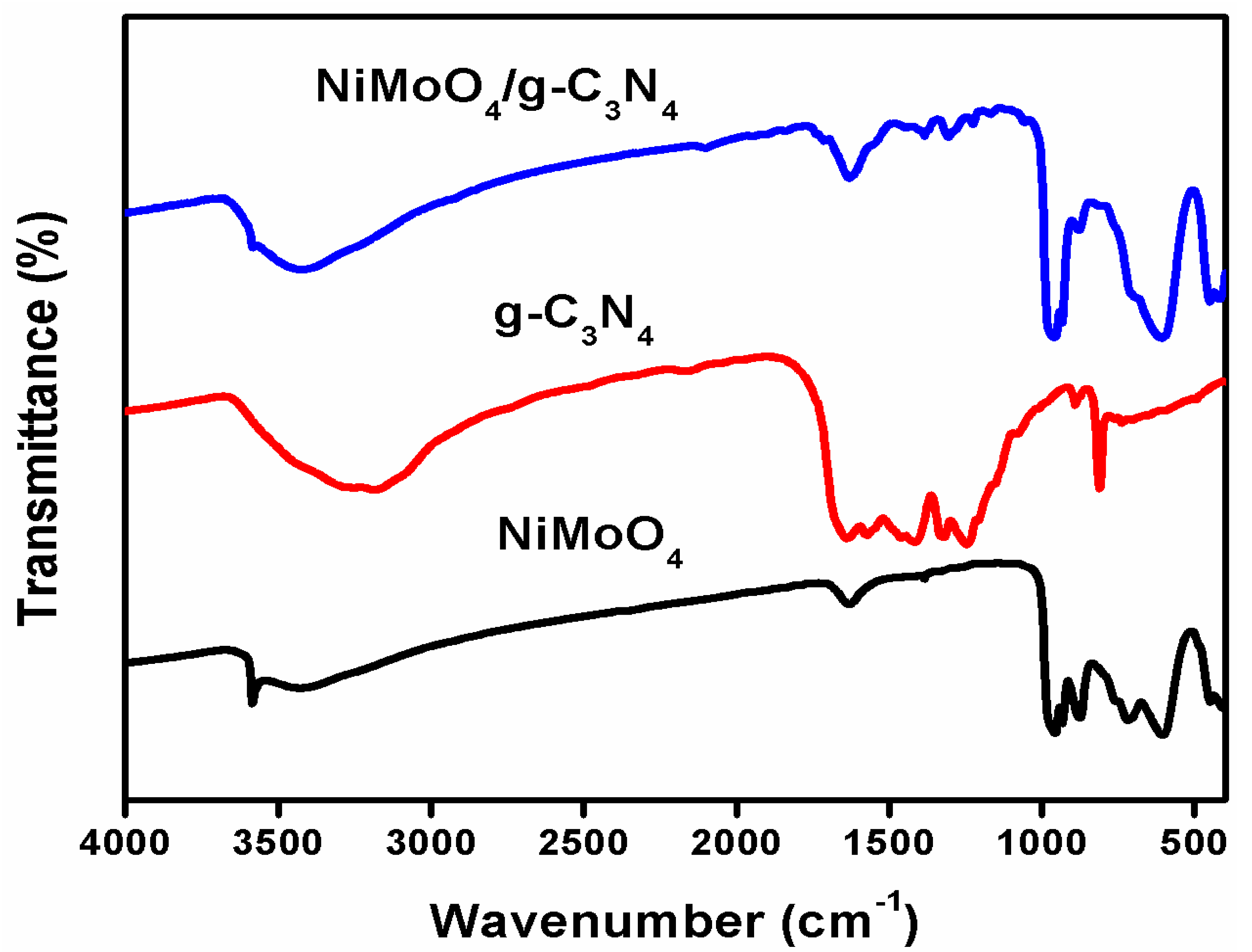
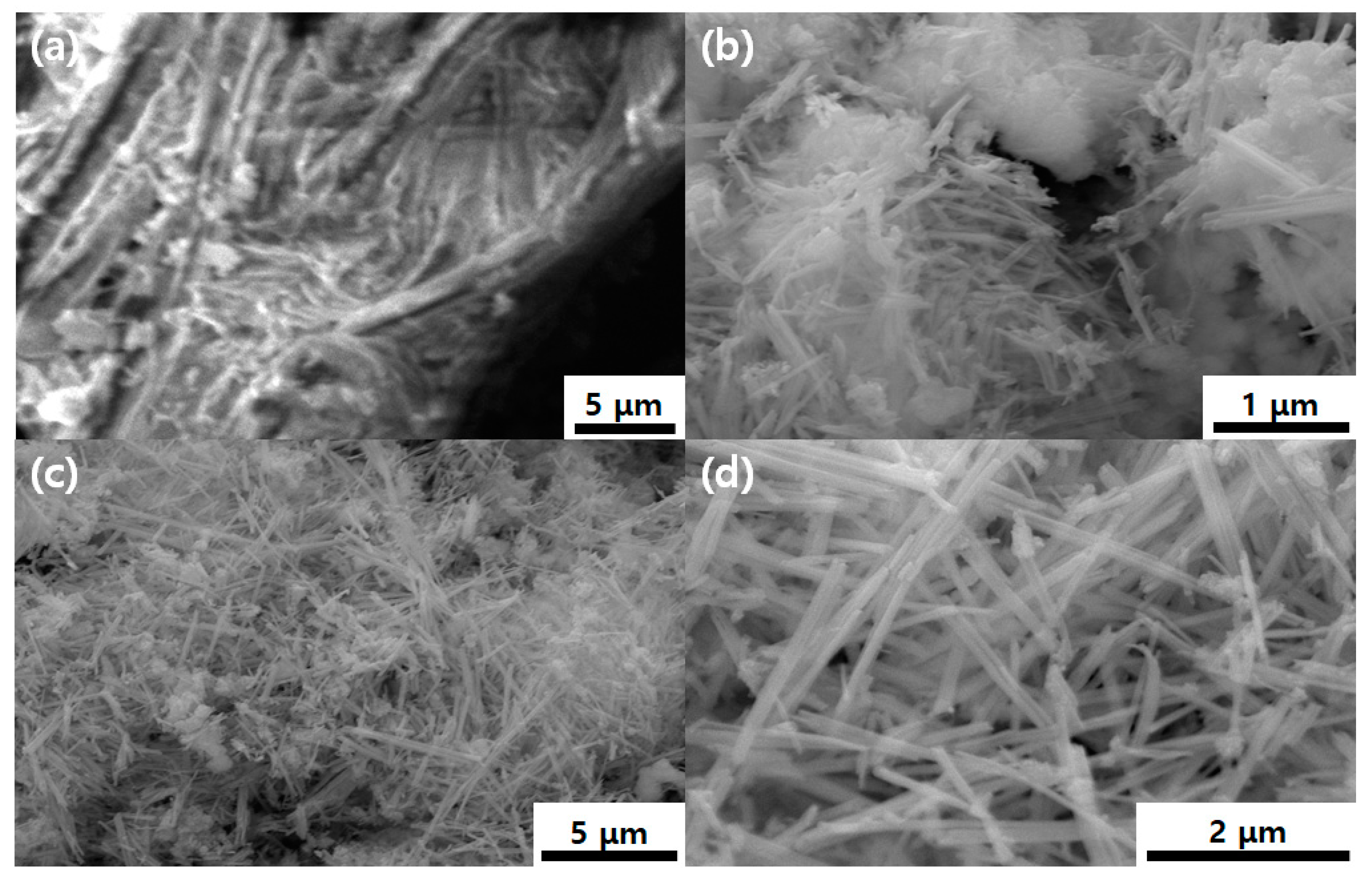
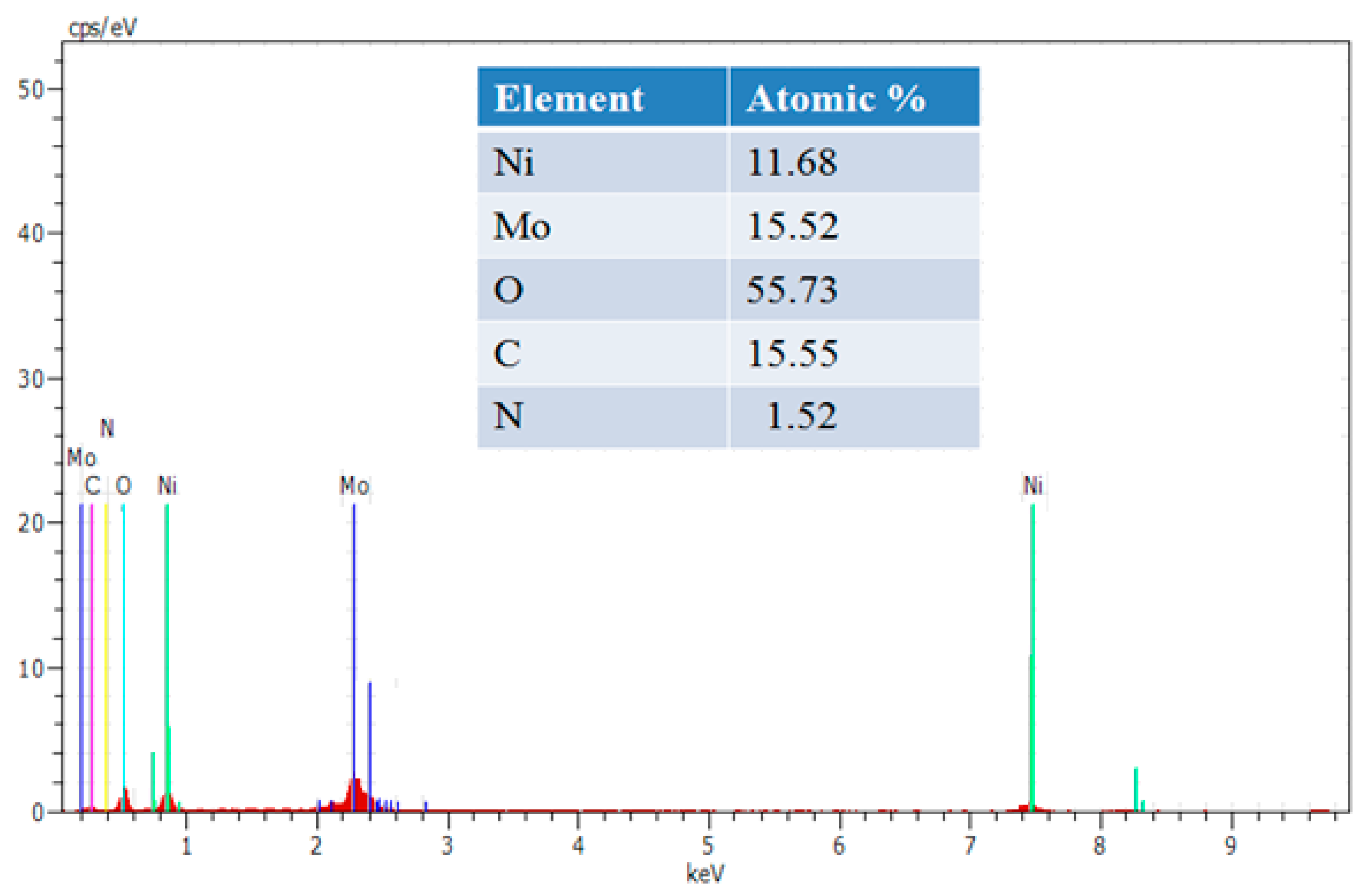

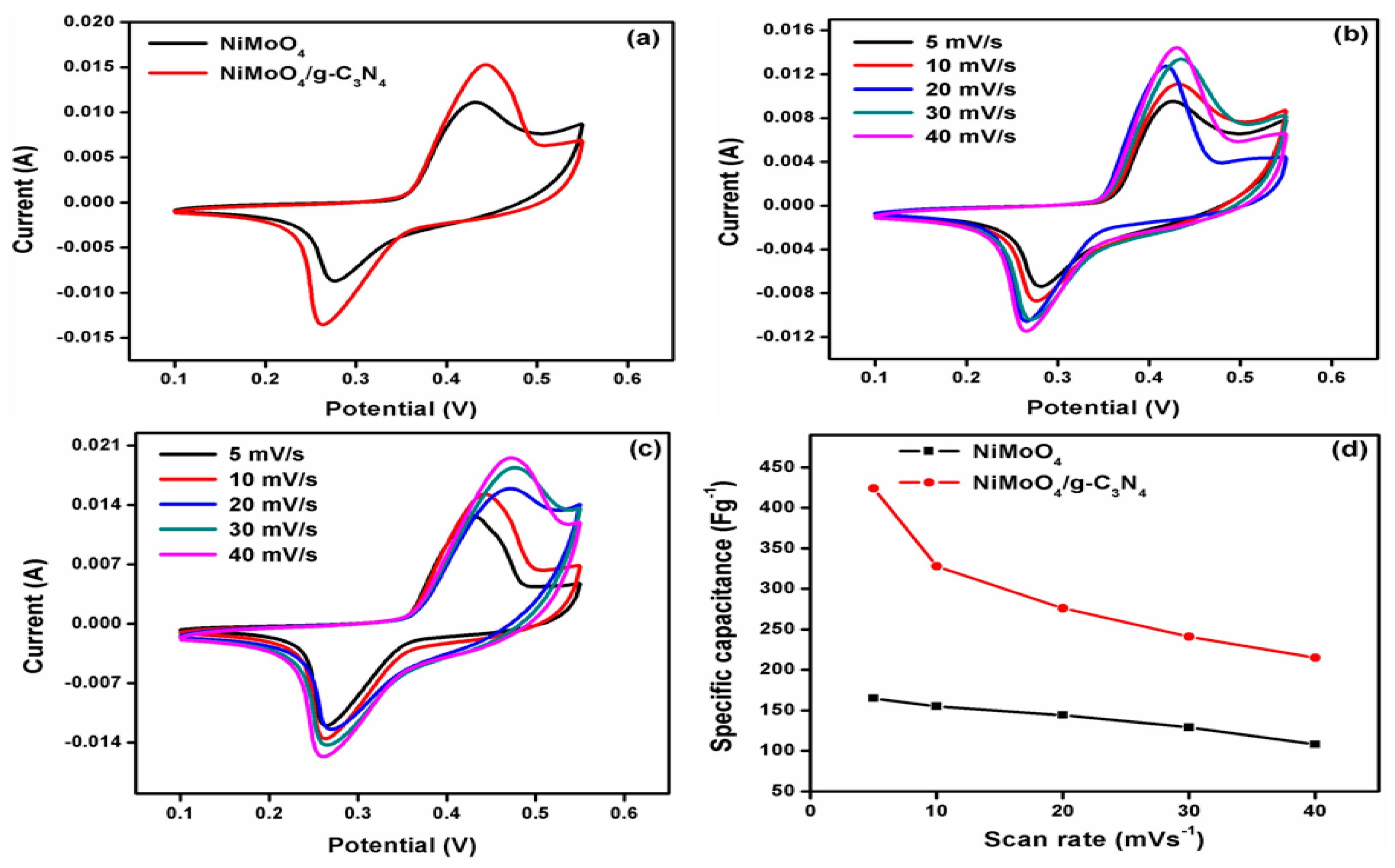
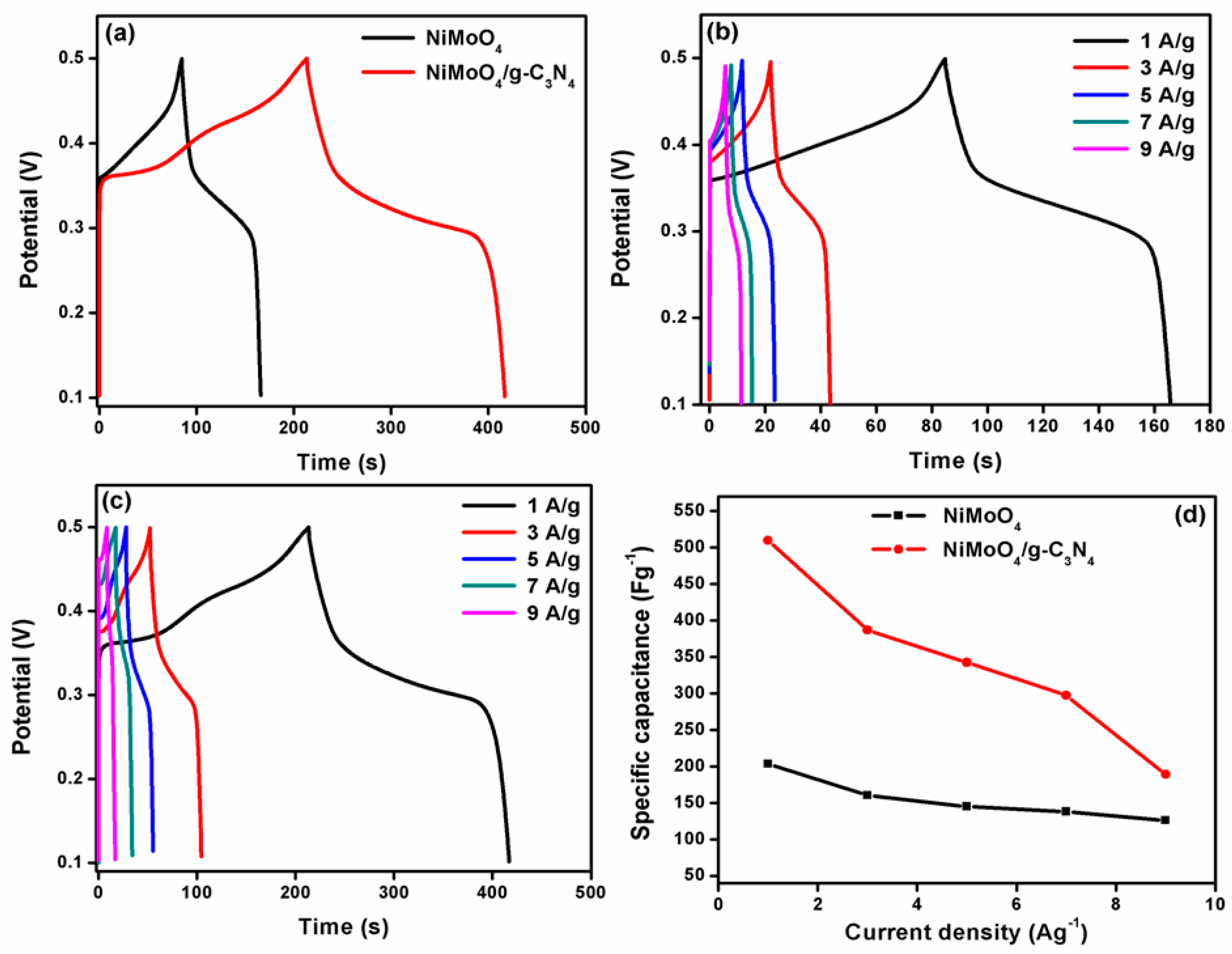

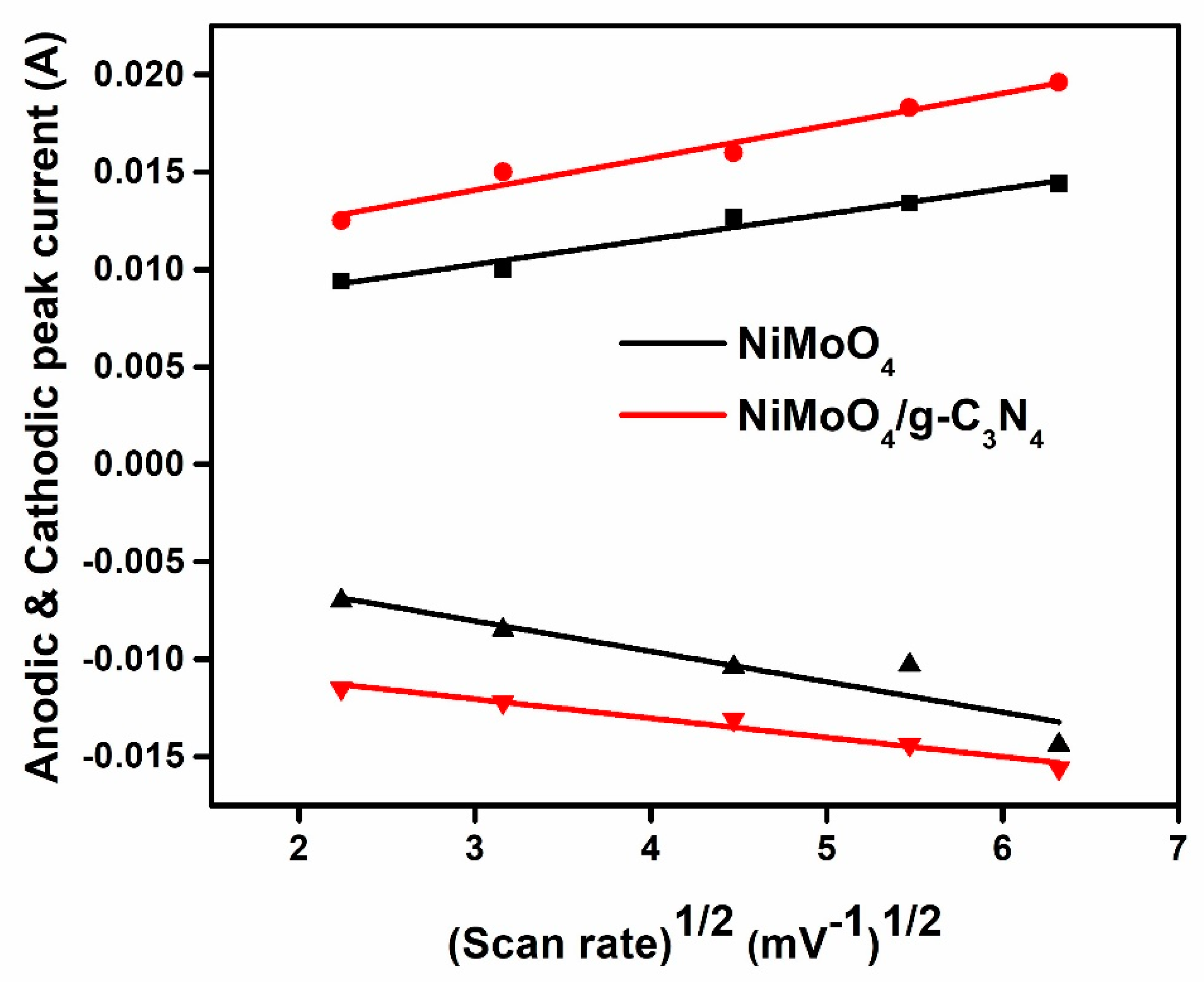
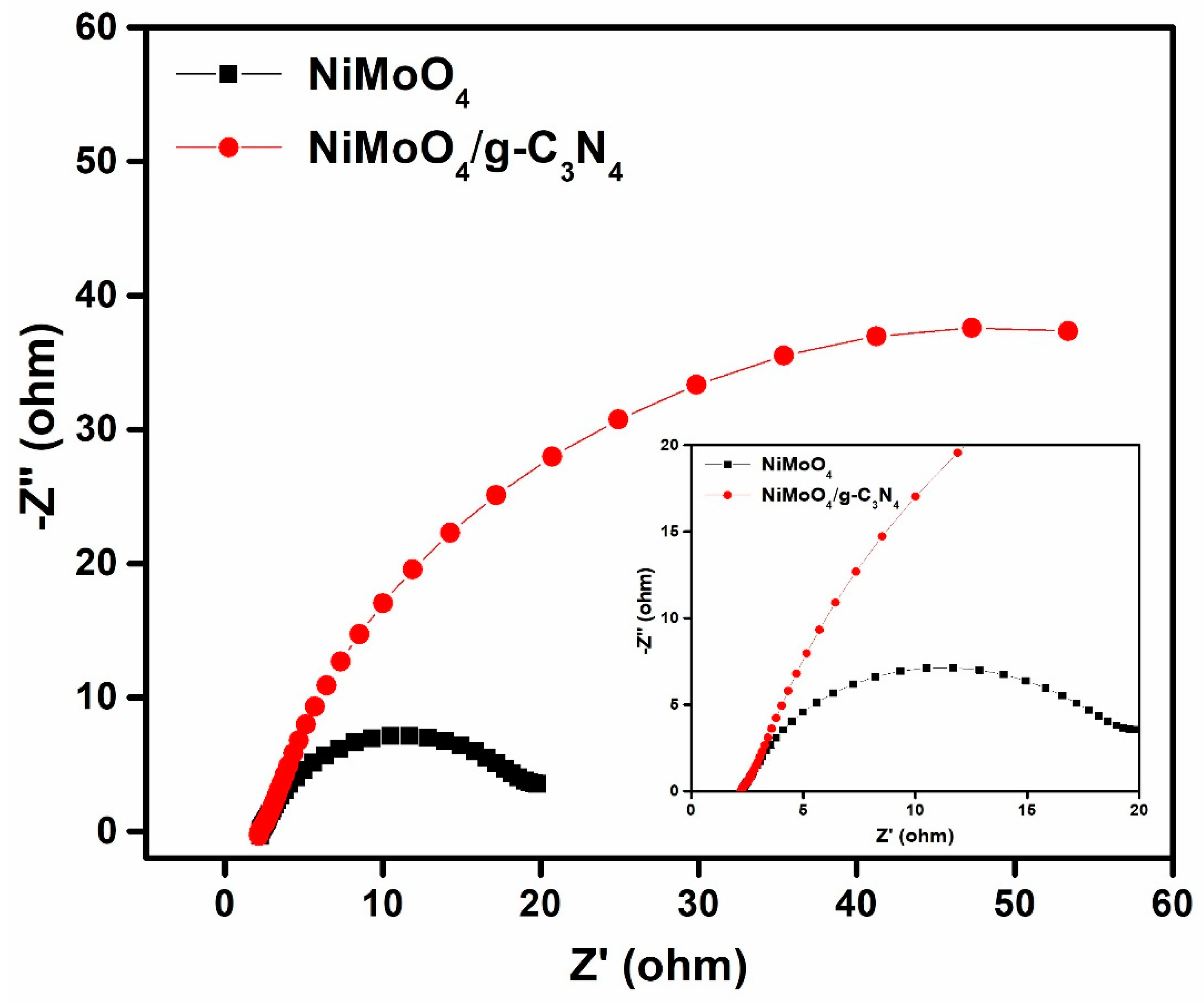
| Sample | Rs (Ω) | Rct (Ω) | Rb (Ω) |
|---|---|---|---|
| NiMoO4 | 2.260 | 0.047 | 2.307 |
| NiMoO4/g-C3N4 | 2.212 | 0.042 | 2.264 |
© 2020 by the authors. Licensee MDPI, Basel, Switzerland. This article is an open access article distributed under the terms and conditions of the Creative Commons Attribution (CC BY) license (http://creativecommons.org/licenses/by/4.0/).
Share and Cite
Thiagarajan, K.; Bavani, T.; Arunachalam, P.; Lee, S.J.; Theerthagiri, J.; Madhavan, J.; Pollet, B.G.; Choi, M.Y. Nanofiber NiMoO4/g-C3N4 Composite Electrode Materials for Redox Supercapacitor Applications. Nanomaterials 2020, 10, 392. https://doi.org/10.3390/nano10020392
Thiagarajan K, Bavani T, Arunachalam P, Lee SJ, Theerthagiri J, Madhavan J, Pollet BG, Choi MY. Nanofiber NiMoO4/g-C3N4 Composite Electrode Materials for Redox Supercapacitor Applications. Nanomaterials. 2020; 10(2):392. https://doi.org/10.3390/nano10020392
Chicago/Turabian StyleThiagarajan, Kannadasan, Thirugnanam Bavani, Prabhakarn Arunachalam, Seung Jun Lee, Jayaraman Theerthagiri, Jaganathan Madhavan, Bruno Georges Pollet, and Myong Yong Choi. 2020. "Nanofiber NiMoO4/g-C3N4 Composite Electrode Materials for Redox Supercapacitor Applications" Nanomaterials 10, no. 2: 392. https://doi.org/10.3390/nano10020392





